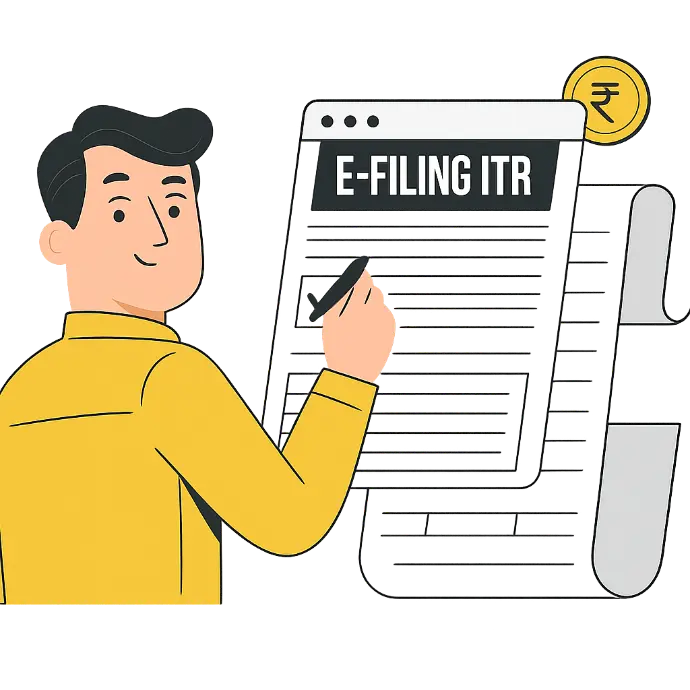
Income Tax Filing and Compliances
What is Income Tax ?
Income tax is a form of direct taxation imposed by the government on the income earned by individuals, businesses, and other entities within a specific period, usually a financial year. It is a significant source of revenue for governments, helping to fund various public services, including healthcare, education, infrastructure, defense, social welfare, and more. Income tax is typically calculated based on the total income earned by an individual or organization, including salary, profits, rental income, capital gains, and other forms of income.
The amount of tax paid depends on the income level, with higher earnings being taxed at higher rates, making income tax a progressive tax system. Taxpayers are required to file an annual tax return, declaring their income and deductions to calculate the tax due. Many countries allow exemptions, deductions, and rebates that help reduce the taxable income, such as deductions for savings, investments, or expenses like healthcare or education.
Individuals, businesses, and corporations must pay income tax on their earnings, with the amount varying depending on their income category. Governments use this revenue to fund essential services and maintain the country’s financial stability. Income tax plays a crucial role in wealth distribution, promoting fairness, and ensuring the smooth functioning of public systems.
Book Now
Sources of Income:

1.Salary
This head includes income earned by an individual through employment. It covers:
- Basic Salary: The fixed amount paid by an employer.
- Allowances: Such as house rent allowance (HRA), dearness allowance (DA), and special allowances.
- Bonus: Extra payments received in addition to the salary.
- Commission: Earnings based on sales or business performance.
- Retirement Benefits: Pension, gratuity, and provident fund contributions.

2.House & Property
This head covers income earned from owning property. It includes:
- Rental Income: Money received from renting out property (residential or commercial).
- Income from self-occupied property: In some cases, even if a property is not rented out, it can be considered under this head for tax calculation.
- Annual Value of Property: Income is assessed based on the potential rental value of the property.

3.Profits and Gains from
Business or Profession
This head includes income earned from carrying out a business or practicing a profession (e.g., lawyers, doctors, consultants). It covers:
- Business Profits: Revenue generated from business activities minus business expenses.
- Professional Fees: Income earned from offering professional services.
- Other Income from Business Activities: This can include earnings from any side activities related to the primary business.

4. Capital Gains
This head includes income earned from the sale of capital assets, such as:
- Real Estate: Income from selling property or land.
- Shares and Securities: Profit from selling stocks, bonds, or mutual funds.
- Other Assets: Income from selling any other form of capital asset like jewelry, vehicles, etc.
- Short-Term Capital Gains (STCG): Profit earned from assets sold within a short period (usually within a year).
- Long-Term Capital Gains (LTCG): Profit earned from assets held for a longer period (usually more than a year).

5.Income from
Other Sources
This is a residual category that includes any income not covered under the other heads, such as:
- Interest Income: Income from savings accounts, fixed deposits, bonds, etc.
- Dividends: Earnings from shares of companies.
- Lottery Winnings: Prizes won through lotteries or contests.
- Gifts: Income from gifts, though large gifts may be taxable under certain conditions.
- Rental Income from Movable Property: Earnings from renting things like cars, machinery, or equipment.
Types of Income Tax Return
In India, there are several types of Income Tax Returns (ITR) forms, each designed for different categories of taxpayers. The primary forms include:
- ITR-1 (Sahaj)
- For: Individuals with income from salary, pension, family pension, one house property, and other sources (interest, etc.).
- Conditions: Total income should be less than ₹50 lakh and cannot have income from business or profession.
- ITR-2
- For: Individuals and Hindu Undivided Families (HUFs) with income from salary, house property, capital gains, and other sources.
- Conditions: Can be used by taxpayers not carrying on business or profession.
- ITR-3
- For: Individuals and HUFs who are carrying on business or profession, as well as earning income from salary, house property, and other sources.
- Conditions: For taxpayers who have income from business or profession.
- ITR-4 (Sugam)
- For: Individuals, HUFs, and firms (other than LLP) with income from a business or profession, opting for the presumptive taxation scheme under Section 44AD, 44ADA, or 44AE.
- Conditions: For taxpayers who declare income under presumptive taxation.
- ITR-5
- For: Firms, LLPs, Association of Persons (AOP), Body of Individuals (BOI), and other similar entities.
- Conditions: Specifically for non-individual entities (other than companies).
- ITR-6
- For: Companies (other than those claiming exemption under section 11, related to charitable or religious purposes).
- Conditions: For companies that do not claim income under Section 11 (for charitable/religious purposes).
- ITR-7
- For: Individuals, HUFs, companies, and firms who are required to file a return under section 139(4A), 139(4B), 139(4C), or 139(4D) (exempt entities such as charitable trusts, political parties, etc.).
- Conditions: For taxpayers who need to file a return under specific sections (non-profit organizations, etc.).